#microcopy
Explore tagged Tumblr posts
Photo
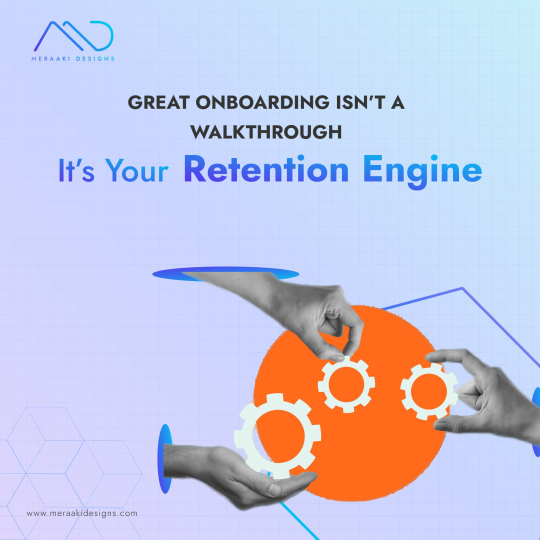
𝐄𝐧𝐭𝐞𝐫𝐩𝐫𝐢𝐬𝐞 𝐒𝐚𝐚𝐒 𝐏𝐥𝐚𝐭𝐟𝐨𝐫𝐦 – 𝐅𝐢𝐱𝐢𝐧𝐠 𝐎𝐧𝐛𝐨𝐚𝐫𝐝𝐢𝐧𝐠 𝐭𝐨 𝐑𝐞𝐝𝐮𝐜𝐞 𝐃𝐫𝐨𝐩-𝐎𝐟𝐟 𝐛𝐲 𝟑𝟕% 🖥️ They had a robust SaaS platform with powerful analytics, but one major flaw—new users rarely got past the first login. Activation was low. Drop-off during onboarding was high. Advanced features were underutilized. Support requests kept growing. 𝐖𝐞 𝐰𝐨𝐫𝐤𝐞𝐝 𝐜𝐥𝐨𝐬𝐞𝐥𝐲 𝐰𝐢𝐭𝐡 𝐩𝐫𝐨𝐝𝐮𝐜𝐭 𝐚𝐧𝐝 𝐠𝐫𝐨𝐰𝐭𝐡 𝐭𝐞𝐚𝐦𝐬 𝐭𝐨 𝐢𝐝𝐞𝐧𝐭𝐢𝐟𝐲 𝐰𝐡𝐞𝐫𝐞 𝐮𝐬𝐞𝐫𝐬 𝐰𝐞𝐫𝐞 𝐬𝐭𝐫𝐮𝐠𝐠𝐥𝐢𝐧𝐠—𝐚𝐧𝐝 𝐫𝐞𝐛𝐮𝐢𝐥𝐭 𝐭𝐡𝐞 𝐞𝐱𝐩𝐞𝐫𝐢𝐞𝐧𝐜𝐞 𝐟𝐫𝐨𝐦 𝐝𝐚𝐲 𝐨𝐧𝐞: Designed a frictionless onboarding with progress tracking Integrated contextual tooltips and learning nudges Reorganized dashboard layout based on feature frequency Rewrote all microcopy for clarity, intent, and tone 𝐄𝐦𝐛𝐞𝐝𝐝𝐞𝐝 𝐩𝐞𝐫𝐬𝐨𝐧𝐚𝐥𝐢𝐳𝐞𝐝 𝐩𝐚𝐭𝐡𝐬 𝐛𝐚𝐬𝐞𝐝 𝐨𝐧 𝐮𝐬𝐞 𝐜𝐚𝐬𝐞 𝐚𝐧𝐝 𝐫𝐨𝐥𝐞: 📉 Result: 37% drop in onboarding abandonment 📈 More users reaching "aha" moments faster 📈 Increase in power users and deeper product engagement The best features don’t matter—if no one gets to them. Great onboarding is more than orientation. It’s your retention strategy. ⚙️ 𝐘𝐨𝐮𝐫 𝐨𝐧𝐛𝐨𝐚𝐫𝐝𝐢𝐧𝐠 𝐢𝐬𝐧’𝐭 𝐚 𝐭𝐮𝐭𝐨𝐫𝐢𝐚𝐥—𝐢𝐭’𝐬 𝐚 𝐟𝐢𝐫𝐬𝐭 𝐢𝐦𝐩𝐫𝐞𝐬𝐬𝐢𝐨𝐧. 𝐈𝐬 𝐲𝐨𝐮𝐫𝐬 𝐛𝐮𝐢𝐥𝐭 𝐭𝐨 𝐜𝐨𝐧𝐯𝐞𝐫𝐭 𝐨𝐫 𝐜𝐨𝐧𝐟𝐮𝐬𝐞? 𝐋𝐢𝐧𝐤 -> https://meraakidesigns.com/?utm_source=facebook&utm_medium=social&utm_campaign=homepage_traffic
#SaaSPlatform#Analytics#Activation#Onboarding#UserExperience#RetentionStrategy#AdvancedFeatures#SupportRequests#UserEngagement#FrictionlessOnboarding#ProgressTracking#Microcopy#ProductEngagement#AhaMoment#meraakidesigns
0 notes
Text
How Tone of Voice Shapes the UX Experience (and Why It Matters More Than Ever)
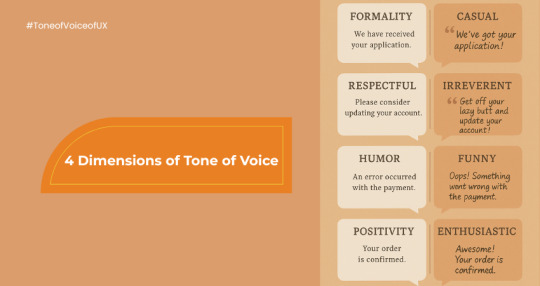
our content isn't just about what you say—it's about how you say it. In UX writing, tone of voice is the unsung hero that builds trust, guides users, and defines your brand personality at every touchpoint.
From casual onboarding copy to serious error messages, knowing how to adjust your tone across the 4 key dimensions—Formal vs Casual, Funny vs Serious, Respectful vs Irreverent, and Enthusiastic vs Matter-of-Fact—can turn passive users into loyal advocates.
Explore the complete breakdown, examples, and a downloadable tone profile worksheet to help your writing team stay aligned.
👉 Read the full post on mayapillaiwrites.com
0 notes
Text
The Psychology Behind Great UX
How to Design for Human Behavior?

Understanding human psychology is the foundation of great UX design. By leveraging cognitive science, behavioral patterns, and psychological principles, designers can create intuitive, engaging, and user-friendly experiences. In this blog, we’ll explore how psychology shapes UX and how to apply these insights to build products that resonate with users.
Cognitive Load: Keeping Interfaces Simple
What Is Cognitive Load? Cognitive load refers to the mental effort required to process information. Too much at once can overwhelm users, leading to frustration and abandonment.
How to Reduce It:
Remove unnecessary elements.
Use familiar design patterns (e.g., standard navigation layouts).
Break content into smaller, digestible chunks.
Prioritize key content for your users.
Example: Google’s homepage reduces cognitive load by focusing on one core action—search.
Hick’s Law: Limiting Choices for Faster Decisions
What Is Hick’s Law? This principle states that decision time increases with the number of choices available.
How to Apply It:
Limit visible options.
Use progressive disclosure for complex tasks.
Highlight primary CTAs with visual hierarchy.
Example: Amazon’s streamlined checkout highlights the ��Buy Now” button, reducing friction.
Fitts’s Law: Designing for Easy Interaction
What Is Fitts’s Law? Fitts’s Law says the time to reach a target depends on its size and distance—larger, closer elements are easier to interact with.
How to Use It:
Create large, easily tappable buttons.
Place key actions within thumb zones (especially on mobile).
Space out touch targets.
Example: Apple’s iOS keyboard ensures usability by placing frequently used keys in easy-to-reach zones.
The Von Restorff Effect: Make It Pop
What Is It? Also known as the “isolation effect,” it suggests users are more likely to notice and remember distinct elements.
How to Apply It:
Use bold or contrasting colors for CTAs.
Highlight key messages with unique visual treatment.
Make errors visually distinct.
Example: Dropbox’s bright blue CTA pops on a white background, driving conversions.
The Serial Position Effect: Strategic Placement
What Is It? People remember the first and last items in a sequence better than those in the middle.
How to Use It:
Place critical links at the top and bottom of navigation.
Start and end sections with high-impact content.
Order form fields by importance.
Example: E-commerce sites often showcase bestsellers at the beginning and end of product lists for maximum engagement.
The Zeigarnik Effect: Nudging Task Completion
What Is It? People remember incomplete tasks more than completed ones, which motivates them to return and finish them.
How to Apply It:
Use progress indicators on multi-step tasks.
Send follow-up emails for unfinished actions.
Apply gamification like completion meters.
Example: Duolingo uses streaks and progress bars to encourage daily use and course completion.
Emotional Design: Building a Connection
What Is Emotional Design? It involves creating UI/UX that triggers emotional responses—joy, satisfaction, trust.
How to Design Emotionally:
Use friendly microcopy (e.g., Slack’s playful messages).
Include delightful animations and transitions.
Apply color psychology to influence feelings (e.g., blue = trust).
Example: Instagram’s heart animation offers instant emotional feedback, strengthening engagement.
Final Thoughts
UX design isn’t just about visual appeal—it’s about aligning with how users think and feel. By applying psychological principles like Hick’s Law, Fitts’s Law, and emotional design, you create experiences that feel natural, intuitive, and rewarding.
#UX Psychology#Cognitive Load#Hick's Law#Fitts's Law#Emotional Design#Zeigarnik Effect#Von Restorff Effect#Serial Position Effect#Behavioral Design#Human-Centered Design#Psychology in UX#Cognitive Science in Design#User Behavior#UX Principles#Interaction Design#UX Best Practices#User Engagement#Design Psychology#UX Strategy#Microcopy#Gamification in UX#Color Psychology#Intuitive UI#UX Trends
1 note
·
View note
Text
In the Details: Raise & Lower
These are the control panels on the wall beside the door of my classroom.

There are three features of the space that can be controlled: lights, window blinds, and wall-mounted displays.

The panel on the left isn't labeled. It just has some boxes and lines on it. The buttons in the right-hand panel are labeled clearly enough to know that there are three zones, each of which can be controlled separately, and that you will be raising and lowering something. At a quick glance, I assumed that those buttons would raise and lower the blinds, because that’s what you do with blinds. Certainly, lights are raised and lowered, typically in a theater setting, but most often, they’re turned on and off.
As it turns out, the panel on the right controls the lights, and the panel on the left controls the blinds. Now that I can examine the panel closely, I see that the boxes are visual representations of windows. At the top, they are white, meaning the blinds open, allowing light to pour in. The window icons on the bottom are dark, suggesting that no light comes through. I can think of better ways to visually represent open and closed blinds, but the simplest solution to this problem would just be to label the panels: blinds, lights. Done.
0 notes
Text
The Role of Microcopy in Web Design: How Tiny Text Makes a Big Impact
Small but mighty! Microcopy is the often-overlooked text that guides users through a website—whether it’s a simple form field, an error message, or a call-to-action. It plays a crucial role in improving user experience and boosting conversions.
Want to learn more about how microcopy enhances web design?
0 notes
Text
Need more Kate x Rae content they’re so doomed yuri
#katerae#raekate#duplirae#mini&many#shrinkingkate#microcopies#macrocopies#kate x rae#rae x kate#duplikate x shrinking rae#dupli-kate x shrinking rae#shrinking rae x duplikate#shrinking rae x dupli-kate#dupli-kate#duplikate#shrinking rae#invincible#katherina cha#kate cha#invincible show#invincible amazon
9 notes
·
View notes
Note
What are your thoughts on the found family Kate, Rae and Monster Girl? They’re so girlfriends and the random 24 year old woman they adopted to me
“This is my girlifriend Kate and our daughter Amanda!”
“You look 20, how is your daughter a young teen?”
“Actually I’m 24”
cook.. but only rlly bc i like katerae haha
if i thought about it more i might understand it fully
3 notes
·
View notes
Text



I’ve been getting sooo much support of my bio teacher and his assistant (i freaking love them 💞) and i’ve been killing it in the lab specially in the field of dissection and microcopy. So i thought i would share some pics of the last couple of weeks
(I fell so cool doing scientific research hehehe)
If you guys like it i could definitely share more pics of the slides i do in the microscope 👀👀
#laboratory#high school#school#academia#research scientist#researchreports#student#studying#studyspo#studyblr#study#biology
20 notes
·
View notes
Text
What AI-based tools assist with UI/UX design iteration?
Several AI-based tools are transforming the way designers approach UI/UX design iteration, making the process faster, more data-driven, and user-focused. If you're working with a professional UI UX design company, you’ll likely see many of these tools integrated into their workflow.
Top AI Tools Assisting in UI/UX Design Iteration:
Uizard Converts hand-drawn sketches into wireframes and functional prototypes. Speeds up early-stage ideation and iteration.
Figma with AI plugins (like Magician or Genius) Enables predictive design suggestions, content generation, and smart layout decisions using generative AI.
Adobe Firefly (within Adobe XD) AI-assisted design generation, automated image editing, and content-aware layout suggestions.
Framer AI Converts plain-text descriptions into interactive website layouts using natural language prompts.
Khroma Uses AI to suggest color palettes based on user preferences, which is great for fast mood board creation.
Attention Insight AI-powered heatmap prediction tool that forecasts where users will focus on your design — useful for validating visual hierarchy before user testing.
Maze Integrates with prototypes to provide AI-generated usability metrics and feedback analysis for better iteration planning.
Jasper or Writesonic Content-focused AI tools that help UX writers generate and test multiple variations of microcopy, CTAs, and onboarding content.
Why Choose a UI UX Design Company?
While these tools are powerful, they perform best when used by experts who understand design psychology, usability principles, and human behavior. A top-tier UI UX design company leverages these AI tools not just for speed, but for delivering delightful, conversion-driven user experiences.
0 notes
Text
The Psychology Behind UI/UX and Brand Identity
User interaction is not just about technology — it’s about human behavior. Every click, scroll, and tap reflects a user’s expectation, emotion, and cognitive flow. This is where the fusion of design psychology and technology becomes vital. Brands that truly stand out are not just beautiful — they are meaningful, usable, and intuitive. And that’s the power of UI UX and logo designing done right.
Understanding the Human Element
Designing interfaces and identities for digital products demands more than just creative flair — it requires a deep understanding of how people think and behave. UI (User Interface) governs how users interact with an app or website visually, while UX (User Experience) encompasses their emotional and practical journey.
Users subconsciously judge a brand’s credibility in just 50 milliseconds. That means your UI/UX design and logo must make a powerful impression almost instantly. By integrating cognitive psychology — like Hick’s Law (decision time increases with more options) or the Von Restorff Effect (distinct elements are more memorable) — designers can shape user behavior in meaningful ways.
Why UI/UX Design and Logo Must Work Together
A consistent and cohesive design language reinforces brand trust. Yet too often, businesses treat UI/UX design and logo creation as isolated tasks. In reality, they are interdependent facets of a unified brand identity.
A logo conveys the essence of a brand at a glance.
UI design supports visual continuity with that identity.
UX ensures that this identity is experienced fluidly throughout the digital journey.
Great branding doesn’t happen by accident — it’s crafted deliberately, and reinforced every time a user interacts with a button, reads a microcopy, or navigates a page.
The Impact on User Retention
You might draw users in with flashy ads, but it’s exceptional UX that makes them stay. Studies show that 88% of users are unlikely to return after a bad experience. Poor navigation, inconsistent typography, or unclear calls-to-action can silently erode your digital presence.
When your UI and UX are thoughtfully designed, users don’t think about how to interact with your product — it just feels natural. And when your logo resonates with that experience, you create lasting brand recall. A unified digital presence builds emotional loyalty, not just convenience.
How Emotions Influence Design Success
Color, shape, and typography don’t just look good — they feel a certain way. Blue evokes trust. Rounded shapes feel friendlier. Serif fonts exude tradition, while sans-serif fonts suggest modernity. When these elements are strategically aligned with your brand purpose, you’re no longer just designing interfaces — you’re designing emotions.
The best UI UX design company doesn’t just push pixels; it decodes the emotional language of design. They understand that every element, from onboarding flows to icon sets, contributes to the brand’s narrative. They listen, research, and then translate your brand into a seamless visual journey.
Micro Interactions: The Silent Storytellers
Ever noticed how a heart icon gently animates when you “like” something on a social media app? That’s a micro interaction — a tiny visual cue that provides feedback and satisfaction. These micro-moments, often overlooked, are powerful emotional anchors in the user journey.
In logo design, similar microelements — like symmetry, negative space, or motion (in digital logos) — can make a logo feel dynamic and alive. This subtle interplay between micro interactions in UI/UX and brand visuals builds a coherent and delightful user experience.
Data-Informed Creativity
Design should never be purely instinctive. Heatmaps, A/B testing, user personas, and journey mapping allow designers to back their decisions with data. But data alone isn’t enough. It’s the interpretation of that data — infused with empathy and creativity — that drives innovation.
When selecting a UI UX design company, prioritize those who balance analytics with artistry. A company that combines conversion goals with compelling narratives will always deliver better outcomes.
Responsive by Design, Inclusive by Default
Modern design isn’t just about aesthetics — it’s about access. Responsive UI/UX ensures that your product works seamlessly across devices, while inclusive design ensures it works for everyone. This includes users with visual impairments, motor limitations, or cognitive differences.
Logo designs, too, must scale effectively from a website header to a mobile app icon to a smartwatch screen. Simplicity and clarity are paramount. Inclusivity should be built into your brand from day one — not treated as an afterthought.
The Strategic Advantage
A polished UI/UX design and a powerful logo aren’t just assets; they’re strategic tools. They help you:
Reduce bounce rates by making your product easier to navigate
Boost conversions through persuasive design flows
Differentiate your brand in a crowded digital market
Build credibility through consistent and human-centered branding
In today’s competitive ecosystem, good design is no longer optional — it’s the front line of your digital strategy.
Thus, Design is not just about how something looks — it’s about how it works and feels. When businesses invest in comprehensive UI UX and logo designing, they invest in their users’ trust, their brand’s memory, and their market relevance. Choosing the right UI UX design company means choosing a partner who understands not just your brand, but your audience’s unspoken needs. Because in the end, great design isn’t just seen — it’s felt.
0 notes
Text
Become a Skilled UI/UX Designer with Job-Oriented Training

INTRODUCTION
In today's digital-first world, every click, swipe, and tap is part of a well-crafted user experience. Behind every seamless interface is a skilled UI/UX designer who understands user needs and turns ideas into engaging digital products. If you’re looking to build a creative career, now is the perfect time to learn UI/UX design from scratch in Yamuna Vihar or Uttam Nagar.
Whether you're a student, fresher, or working professional, a job-oriented UI/UX Design Course can open doors to high-demand roles in web and app design. Let’s explore how professional training can transform your career and help you become a successful designer.
Why Choose UI/UX Designing as a Career?
The demand for UI/UX designers has grown significantly with the rise of mobile apps, websites, and digital platforms. Businesses are investing in user-centric design to stay ahead, and that means UI/UX professionals are in high demand.
Enrolling in a Complete UI UX Design Course in Yamuna Vihar or Uttam Nagar equips you with essential skills like:
Wireframing & Prototyping
User Research & Personas
Visual Design Principles
Responsive Web Design
Design Tools like Figma, Adobe XD, and Sketch
With the right UI UX Designer Training in Yamuna Vihar or Uttam Nagar, you don’t just learn theory—you work on real projects, build a portfolio, and become job-ready.
What You’ll Learn in a Job-Oriented UI/UX Design Program
A Professional UI UX Designer Course in Yamuna Vihar or Uttam Nagar is designed to give you end-to-end knowledge of the entire design process. From understanding user behavior to creating interactive prototypes, the curriculum covers:
Understanding User Flow
Designing Clean Interfaces
Accessibility in Design
UX Writing & Microcopy
Conducting Usability Tests
Collaborative Design Process
The best part? You get to learn in hands-on UI UX Design Classes near me in Yamuna Vihar or Uttam Nagar where mentors guide you through live projects and practical assignments.
Why Location Matters: Learn Near You
Searching for UI UX Design Classes Near Me in Yamuna Vihar or Uttam Nagar? Local training centers allow you to study in a classroom environment while also offering online flexibility. It’s a win-win!
Personalized mentorship
Face-to-face doubt sessions
Real-time feedback on design projects
Industry-oriented curriculum
Whether you prefer in-person UI UX Design Classes in Yamuna Vihar or need UI UX Designer Training in Uttam Nagar, a good institute will help you learn efficiently and prepare for internships or full-time jobs.
Get Certified and Get Noticed
Employers today value certified skills. That’s why it’s important to choose the Best UI UX Design Course Online with Certificate in Yamuna Vihar or Uttam Nagar. A professional certificate boosts your resume and validates your capabilities in a competitive field.
Showcase your certification on LinkedIn
Build a strong design portfolio
Apply confidently to junior or intern roles in startups and agencies
With a Complete UI UX Design Course in Uttam Nagar, you can take your design career to the next level, starting right from your neighborhood.
Who Can Join the Course?
Students pursuing design or IT
Working professionals looking to switch careers
Freelancers and entrepreneurs
Anyone interested to Become a Professional UI UX Designer in Yamuna Vihar or Uttam Nagar
The programs are beginner-friendly, making it easy for anyone to learn UI UX design from scratch in Yamuna Vihar or Uttam Nagar.
Final Thoughts
Design is no longer just about visuals—it’s about how users feel when they use a product. With the right training from a reliable UI UX Design Institute in Yamuna Vihar or Uttam Nagar, you can master this in-demand skill and step confidently into the digital world.
Whether you're starting your career or upgrading your skills, a Professional UI UX Designer Course in Uttam Nagar or Yamuna Vihar can shape your future. Don’t wait—start learning and designing today!
📚 Learn Become A Professional UI/UX Designer: Attitude Academy
📍 Visit Us: Yamuna Vihar | Uttam Nagar
📞 Call: +91 9654382235
🌐 Website: www.attitudetallyacademy.com
📩 Email: [email protected]
📸 Follow us on: attitudeacademy4u
0 notes
Text
What Is UX Design? A Complete Guide to User Experience
UXdesign
Introduction
User Experience (UX) design is the art and science of crafting digital products that are intuitive, meaningful, and pleasurable to use. It focuses on understanding how people interact with websites, apps, and systems—then designing experiences that feel natural and effective. Far more than just aesthetics, UX design blends behavioral research, information architecture, interaction design, and continuous user testing to build experiences that resonate deeply.

1. Defining UX Design
UX design centers on users—their needs, motivations, and behaviors. It's defined as the full spectrum of a user's perceptions and responses gained through interaction with a product, service, or company
UX design is not limited to UI; it shapes the end-to-end journey, encompassing:
Usability – Can users complete tasks easily and efficiently?
Accessibility – Can everyone, including people with disabilities, use it comfortably?
Desirability – Does the experience evoke positive feelings?
Reliability – Does it perform consistently?
It puts humans first, ensuring design decisions are data- and empathy-driven—not just stylistic.
2. Why UX Design Matters
Well-executed UX:
Boosts satisfaction and engagement, leading to higher retention rates
Improves conversions—purchase flows and form submissions become frictionless
Reduces costs and errors, catching issues early before they escalate
Builds brand reputation, signaling reliability and care
In short, UX design translates directly into healthier bottom-line results and happier users.
3. Core Principles of UX Design
According to industry standards, the essential principles include:
Principle
Description
User-Centered Design
Always involve users—through empathy, research,
Usability & Simplicity
Keep interfaces intuitive—reduce complexity
Accessibility
Design for diverse needs—keyboard navigation, color contrast, alt text
Consistency
Use standard patterns and brand alignment
Feedback
Provide clear, timely cues for user actions
Visual Hierarchy
Guide focus through layout—size, contrast, spacing
Iterative Design
Test, refine, repeat based on real user feedback
Design isn't static—it's a dynamic, evolving process.
4. The UX Design Process
A. User Research
Conduct interviews, surveys, and tests to learn about behaviors and pain points .
B. Information Architecture
Map out site structure and navigation to match user expectations daltoncraighead.com+15careerfoundry.com+15oshyn.com+15.
C. Wireframing and Prototyping
Create quick layouts and interactive versions for early-user testing .
D. Visual & Interaction Design
Define UI, interactions, animations, and brand visual style .
E. Usability Testing
Observe real users completing tasks to identify flaws
F. Implementation & Launch
Collaborate with developers to bring design to life.
G. Analytics & Iteration
Track heatmaps, flow data, A/B test, and refine based on actual user behavior .
5. UX Laws & Heuristics
UX design often uses established laws to guide decisions:
Hick’s Law: Simplify choices to avoid decision overload
Law: Make clickable targets large and accessible
Miller’s Law: Group information into manageable chunks
Heuristic Principles: Jakob Nielsen's guidelines—visibility, control, consistency, error prevention, and recovery en.wikipedia.org
These principles guide clear, usable designs.
6. UX vs. UI vs. CX
UX (User Experience) covers the full user journey.
UI (User Interface) focuses on visual elements (buttons, color, typography).
CX (Customer Experience) includes UX along with broader factors like marketing, product support, and delivery service
UX sits at the heart of the digital interface experience.
7. Emerging Trends in UX Design
Advancing trends shape how UX evolves:
Cultural fluency: Designing with cultural context, not a one-size-fits-all approach wired.com
Voice & conversational UI: Requires precise microcopy and tone
Accessibility-first: inclusivity becoming mainstream—keyboard, screen reader, color contrast compliance
8. UX Design Careers and Tools
UX fields include roles like:
UX Designers, Researchers, Consultants—with average salaries around £57k in the UK
Essential Tools:
Figma, Sketch, Adobe XD for design/prototyping
InVision for sharing mock-ups
Google Analytics, Hotjar for behavior insights
WAVE, Lighthouse for accessibility testing
Conclusion
UX design is a multi-disciplinary, user-centered practice that merges research, creativity, and iteration. Prioritizing users leads to meaningful experiences, loyal customers, and business success. In an increasingly digital world, UX isn’t optional—it’s essential.
FAQs
1. Do UX designers need coding skills? Not necessarily—knowing HTML/CSS helps but isn't required.
2. How long does a UX project take? Landing pages can take weeks; full apps may take months.
3. Is UX only for digital products? No—UX principles apply to service design, physical products, and environments too.
4. Can I transition into UX without a degree? Yes—build a portfolio, volunteer on projects, and show your design process.5. How do I test my UX designs? Use usability testing, heatmaps, session recordings, and A/B tests to get real feedback.
0 notes
Text
How AI & Machine Learning Are Changing UI/UX Design

Artificial Intelligence (AI) and Machine Learning (ML) are revolutionizing UI/UX design by making digital experiences more intelligent, adaptive, and user-centric. From personalized interfaces to automated design processes, AI is reshaping how designers create and enhance user experiences. In this blog, we explore the key ways AI and ML are transforming UI/UX design and what the future holds.
For more UI/UX trends and insights, visit Pixelizes Blog.
AI-Driven Personalization
One of the biggest changes AI has brought to UI/UX design is hyper-personalization. By analyzing user behavior, AI can tailor content, recommendations, and layouts to individual preferences, creating a more engaging experience.
How It Works:
AI analyzes user interactions, including clicks, time spent, and preferences.
Dynamic UI adjustments ensure users see what’s most relevant to them.
Personalized recommendations, like Netflix suggesting shows or e-commerce platforms curating product lists.
Smart Chatbots & Conversational UI
AI-powered chatbots have revolutionized customer interactions by offering real-time, intelligent responses. They enhance UX by providing 24/7 support, answering FAQs, and guiding users seamlessly through applications or websites.
Examples:
Virtual assistants like Siri, Alexa, and Google Assistant.
AI chatbots in banking, e-commerce, and healthcare.
NLP-powered bots that understand user intent and sentiment.
Predictive UX: Anticipating User Needs
Predictive UX leverages ML algorithms to anticipate user actions before they happen, streamlining interactions and reducing friction.
Real-World Applications:
Smart search suggestions (e.g., Google, Amazon, Spotify).
AI-powered auto-fill forms that reduce typing effort.
Anticipatory design like Google Maps estimating destinations.
AI-Powered UI Design Automation
AI is streamlining design workflows by automating repetitive tasks, allowing designers to focus on creativity and innovation.
Key AI-Powered Tools:
Adobe Sensei: Automates image editing, tagging, and design suggestions.
Figma AI Plugins & Sketch: Generate elements based on user input.
UX Writing Assistants that enhance microcopy with NLP.
Voice & Gesture-Based Interactions
With AI advancements, voice and gesture control are becoming standard features in UI/UX design, offering more intuitive, hands-free interactions.
Examples:
Voice commands via Google Assistant, Siri, Alexa.
Gesture-based UI on smart TVs, AR/VR devices.
Facial recognition & biometric authentication for secure logins.
AI in Accessibility & Inclusive Design
AI is making digital products more accessible to users with disabilities by enabling assistive technologies and improving UX for all.
How AI Enhances Accessibility:
Voice-to-text and text-to-speech via Google Accessibility.
Alt-text generation for visually impaired users.
Automated color contrast adjustments for better readability.
Sentiment Analysis for Improved UX
AI-powered sentiment analysis tools track user emotions through feedback, reviews, and interactions, helping designers refine UX strategies.
Uses of Sentiment Analysis:
Detecting frustration points in customer feedback.
Optimizing UI elements based on emotional responses.
Enhancing A/B testing insights with AI-driven analytics.
Future of AI in UI/UX: What’s Next?
As AI and ML continue to evolve, UI/UX design will become more intuitive, adaptive, and human-centric. Future trends include:
AI-generated UI designs with minimal manual input.
Real-time, emotion-based UX adaptations.
Brain-computer interface (BCI) integrations for immersive experiences.
Final Thoughts
AI and ML are not replacing designers—they are empowering them to deliver smarter, faster, and more engaging experiences. As we move into a future dominated by intelligent interfaces, UI/UX designers must embrace AI-powered design methodologies to create more personalized, accessible, and user-friendly digital products.
Explore more at Pixelizes.com for cutting-edge design insights, AI tools, and UX trends.
#AI in UX Design#Machine Learning UX#UX Personalization#Conversational UI#Predictive UX#AI Chatbots#Smart UX Tools#UI Automation#Voice UI Design#Inclusive UX Design#Sentiment Analysis in UX#Future of UX#AI UX Trends 2025#Figma AI Plugins#Accessibility with AI#Adaptive UI Design#UX Innovation#Human-Centered AI#Pixelizes Blog#UX Strategy
2 notes
·
View notes
Text
Digital Intimacy: When Brands Know You Better Than People Do

In a world where customers and brands often never meet face-to-face, the most powerful marketing tool isn’t flashy design or paid reach—it’s digital intimacy. This quiet, evolving force is changing how we perceive brand relationships, moving beyond traditional communication to create genuine emotional bonds with audiences across screens.
Digital intimacy is subtle but powerful. It’s the moment a brand seems to know what you need before you even ask. It's when a late-night Spotify playlist feels handcrafted for your mood or when Netflix suggests exactly what you didn’t know you were craving. It’s not coincidence—it’s a curated, data-informed experience delivered with emotional intelligence.
What Is Digital Intimacy?
Digital intimacy is the ability of a brand to create closeness and relevance through online interactions. It blends personalization, emotional connection, and timing in a way that builds trust and loyalty without ever meeting the customer in person.
It’s not surveillance—it’s sensitivity. The difference lies in how data is used. Is it to manipulate or to serve? The brands that get digital intimacy right use data to anticipate, not to intrude.
Why It Matters Now More Than Ever
The pandemic accelerated digital transformation in every sector. Physical distance became a norm, and with it came the need to feel connected online. Consumers began to crave warmth, empathy, and personal attention in digital interactions—expectations that are still rising.
According to a 2024 Salesforce State of Marketing report, 73% of customers expect companies to understand their unique needs and expectations. But here’s the twist: only 26% feel like brands truly do.
This gap between expectation and delivery has made digital intimacy a business imperative, not just a marketing tactic.
The Anatomy of a Digitally Intimate Brand
Building digital intimacy requires intention and consistency. Here’s what defines the brands that do it well:
Hyper-Personalization Go beyond using a customer’s first name in an email. Real personalization is about relevance—timing, context, and emotional tone.
Human-Centered UX Interfaces that feel intuitive, comforting, and empathetic create a sense of ease. Think of Google’s clean layout or Airbnb’s friendly microcopy.
Proactive Communication Brands that anticipate customer questions or reach out before a problem arises feel more like a partner than a vendor.
Emotional Storytelling Digital intimacy is emotional. Brands that tell stories—of customers, employees, or founders—humanize their identity.
Two-Way Dialogue Engagement isn’t just broadcasting—it’s listening. Replying to comments, incorporating feedback, and building community fosters closeness.
Examples of Digital Intimacy in Action
Spotify Wrapped A yearly tradition that turns data into celebration. People don’t just consume their Wrapped; they share it because it feels personal.
Nike Run Club Offers encouragement, tracks progress, and sends motivational reminders. It feels like a coach in your pocket—not just a brand selling shoes.
Headspace App Uses soothing design, personalized meditation tracks, and empathetic push notifications to make users feel understood.
These experiences aren’t “salesy,” but they convert. Why? Because they build trust—one of the core pillars of Google’s E-E-A-T framework.

Aligning Digital Intimacy with E-E-A-T
Google’s Experience, Expertise, Authoritativeness, and Trustworthiness (E-E-A-T) framework supports the same principles that underlie digital intimacy.
Experience Brands must show they’ve been through the journey their customers are on. Testimonials, behind-the-scenes content, or UGC (user-generated content) can help build this shared experience.
Expertise It’s not just about having knowledge, but delivering it in a way that’s relatable. A brand blog should feel like a conversation, not a lecture.
Authoritativeness People trust brands that others trust. Featuring expert collaborations, customer reviews, and media mentions reinforces this.
Trustworthiness Privacy transparency, ethical use of data, and consistency in tone help build long-term digital trust.
This is particularly relevant in local markets where consumers are still adapting to newer digital habits. As businesses and professionals deepen their digital marketing skills through a Digital Marketing Course Chennai, they’re learning to design for intimacy—not just visibility.
The Tools Behind the Connection
To create intimacy at scale, brands are leveraging:
Behavioral Analytics: Tools like Mixpanel or Hotjar help understand how users navigate websites or apps, revealing where friction—or opportunity—exists.
CRM Personalization Engines: Platforms like HubSpot or Salesforce use AI to tailor content, email flows, and offers based on user behavior.
Conversational Interfaces: Chatbots that remember your preferences or virtual assistants that adjust tone based on sentiment help maintain a personalized dialogue.
But tools alone aren’t enough. What matters is intention. Just because you can automate doesn’t mean you should. Digital intimacy is a blend of automation and human oversight.
Cultural Sensitivity and Emotional Design
Another emerging dimension of digital intimacy is cultural awareness. Brands are realizing that one-size-fits-all content can feel cold or even alienating. Localization—done respectfully—can amplify connection.
Designing for emotional impact is another key trend. Fonts, colors, microcopy, and even loading animations contribute to how users feel about your digital presence.
And remember, silence is also part of intimacy. Over-notifying, over-sending, or over-pitching can turn a warm touch into digital noise.
Future Outlook: Where Digital Intimacy Is Headed
As generative AI becomes more prevalent, brands will need to work harder to maintain authenticity. There’s a growing skepticism toward generic, AI-generated content. Consumers want to know that a real human cared about their experience.
In 2025 and beyond, the brands that lead won’t be the ones with the most automation—they’ll be the ones with the most empathy.
This mindset shift is reshaping how professionals approach their careers in marketing and SEO. In fast-evolving digital hubs, the demand for humanized skillsets is rising. That’s why more people are opting for Certification Courses for SEO Chennai, not just to master tools, but to understand how to build trust-based, intimate digital strategies that reflect evolving consumer expectations.
Conclusion: Closeness Without Contact
In a world where human connection feels more valuable than ever, digital intimacy is the bridge between brands and hearts. It’s not about marketing harder—it’s about marketing smarter, with empathy and relevance at every touchpoint.
For marketers, the challenge is clear: can your brand make someone feel seen, heard, and understood—without ever meeting them?
As the digital economy matures and more local businesses embrace nuanced marketing strategies, the need for emotional intelligence and strategic personalization grows—driving more professionals toward learning experiences like a Digital Marketing Course Chennai, where the focus isn’t just on clicks, but on connection.
0 notes
Text
In the Details: Tap to Unlock
I was in Denver last week for a design sprint and staying in an Embassy Suites. I checked in ahead of time via the Hilton Honors app and went straight to my room. When I first pulled up my digital key, I was instructed to stand close to the door. When I got close, the screen updated to say, "Tap to unlock."
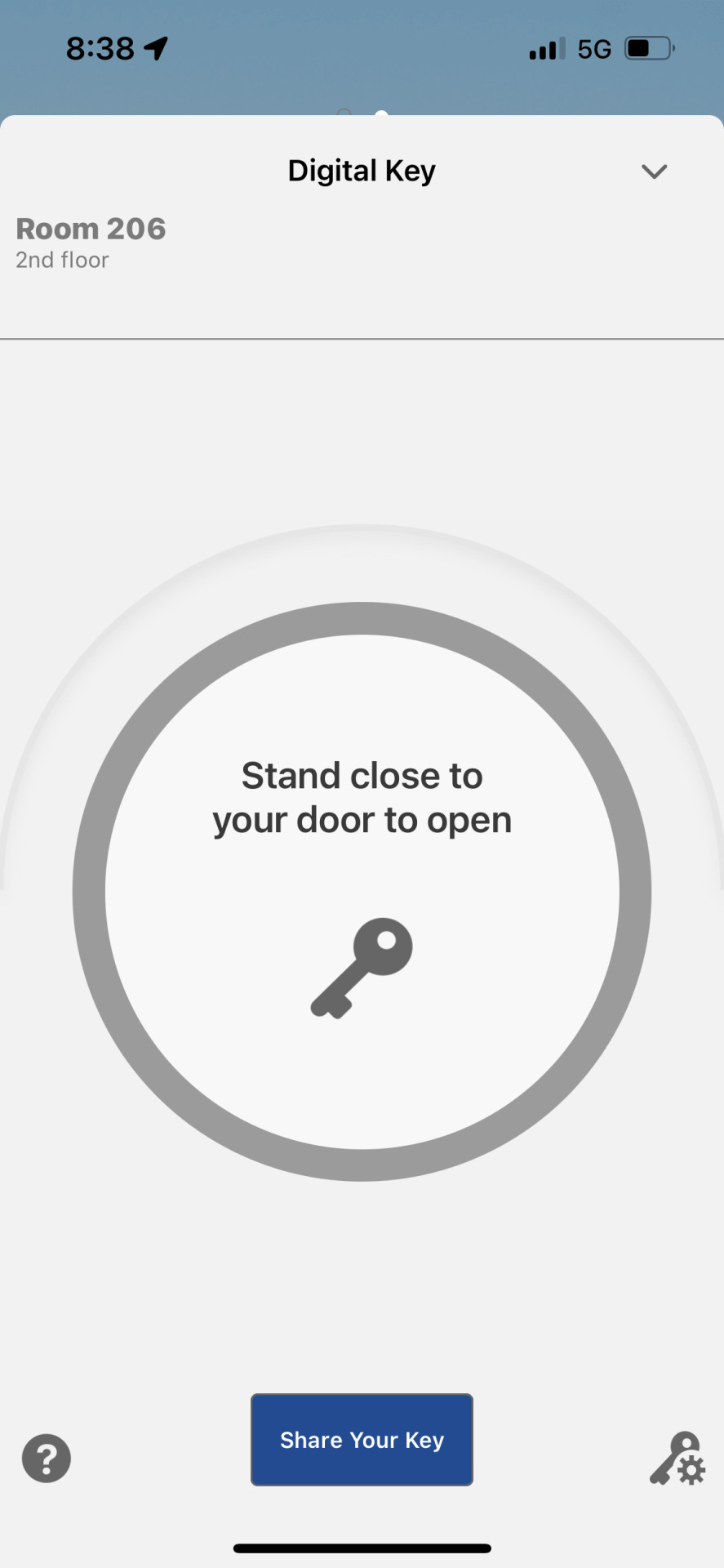
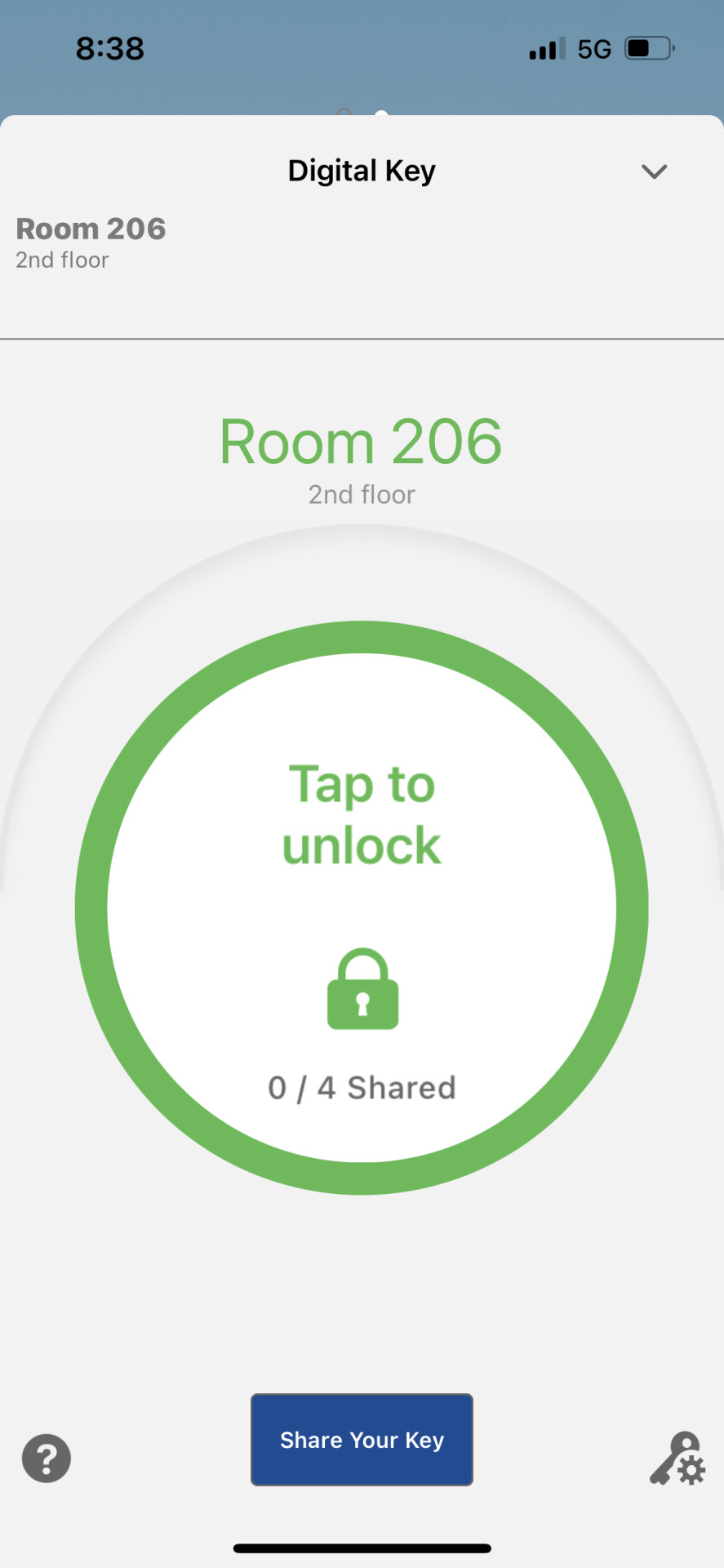
So, I tapped my phone on the sensor on the door. This caused my Apple Card in the Wallet app to open, at which point I was given an error. I switched back to the Hilton app and tried again. I got the same result.
Then it occurred to me that the instruction in the app was trying to tell me to tap the screen of the phone to unlock the door, not tap the phone to the door. This goes against the conditioning I've received in other hotels, where I could just tap my phone or watch to the door without even opening an app. It also flies in the face of the more common "tap to pay".
I went back into the app and tapped the screen.
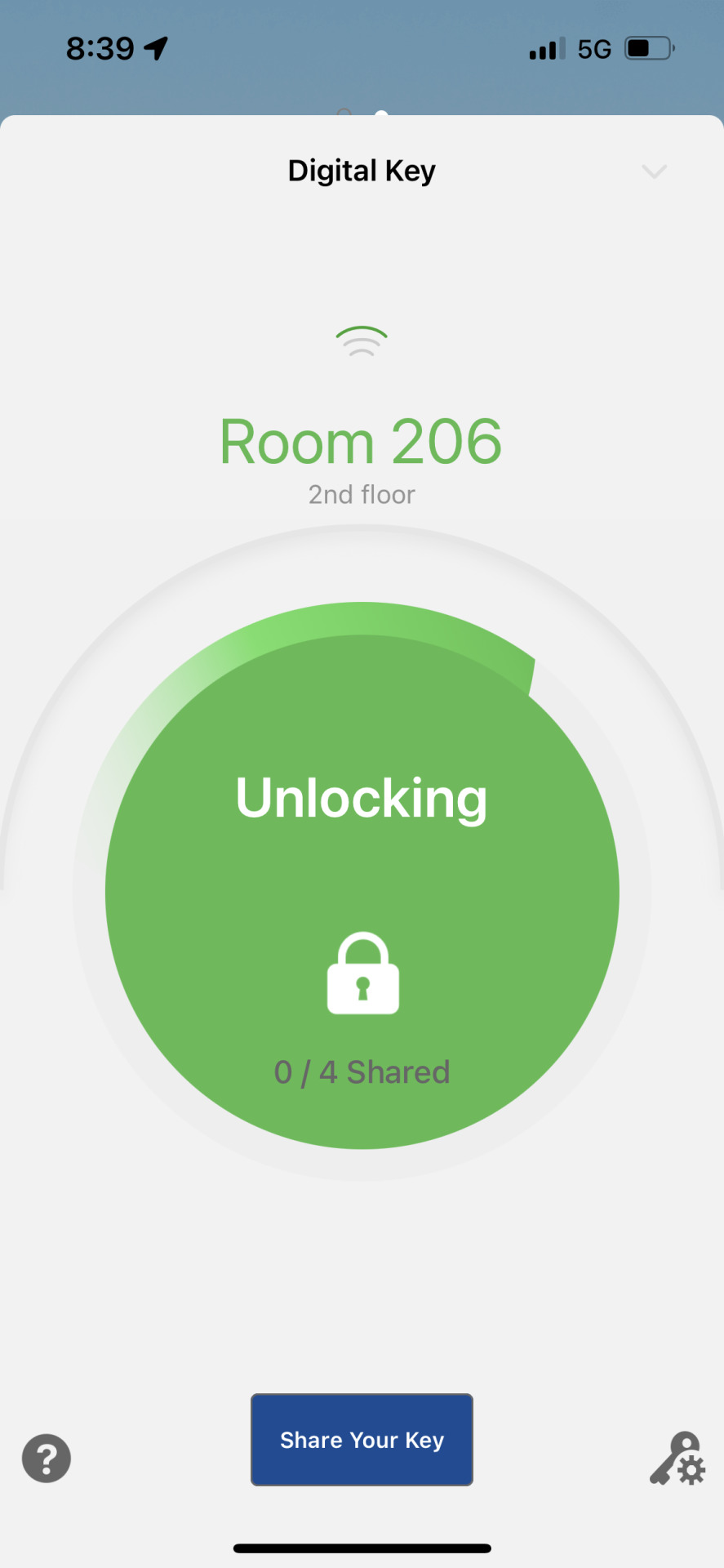
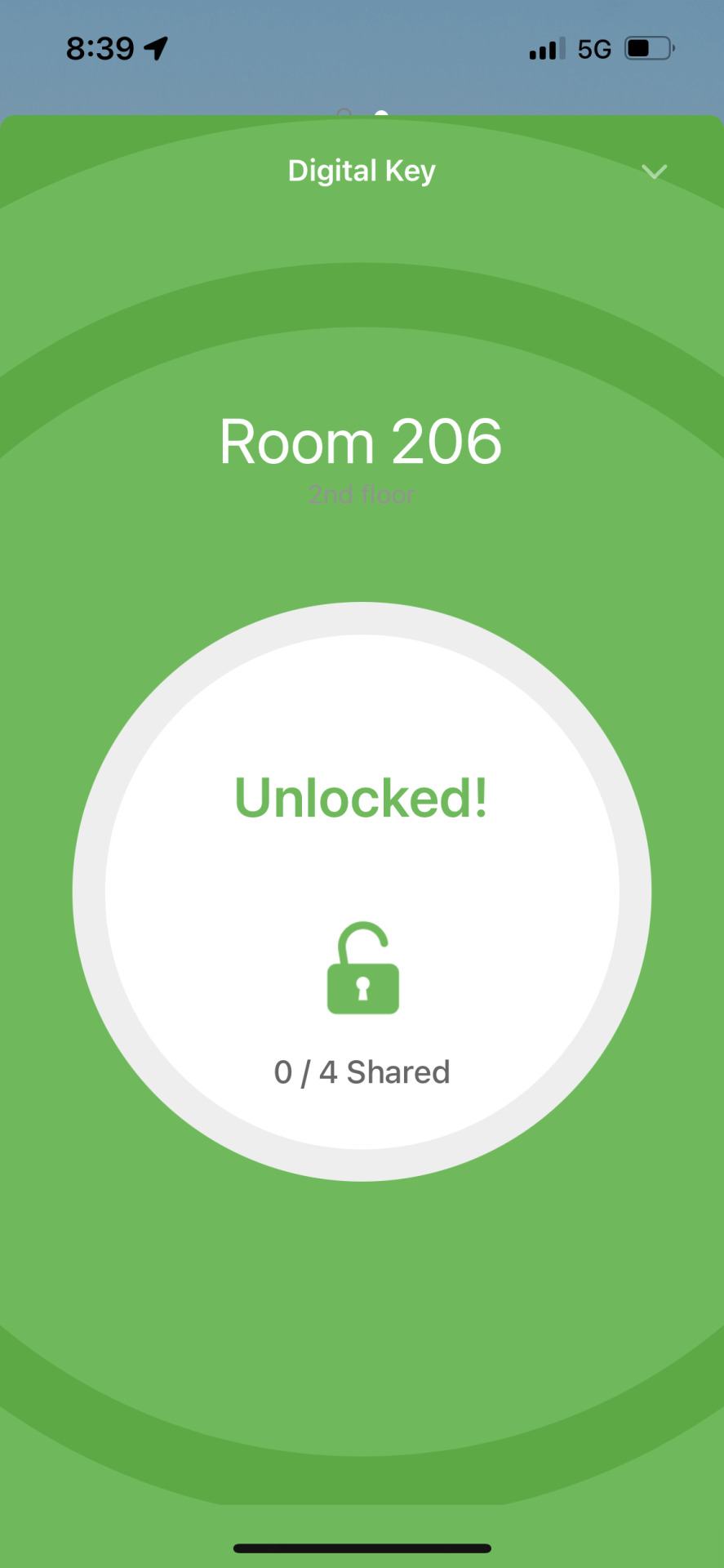
This confusion could be avoided by a slightly more specific instruction, like "Tap here to unlock".
0 notes
Text
📢 Microcopy: The Small Text That Makes a Big Difference!
Ever wondered how a simple "Buy Now" button or a short error message can improve your experience on a website? That's the power of microcopy! It’s the tiny text that guides users, enhances navigation, and even boosts conversions. Arvani Solutions breaks it all down in their latest article.
0 notes